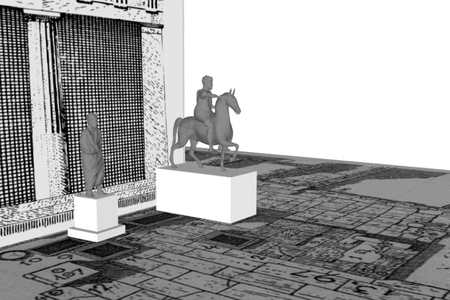Duke Academic Quad, circa 1932 (Duke University Archives)
By Becca Bayham
Perkins Library didn’t always look the way it does now. Since the sanctum of scholarly thought was built in 1928, it has been expanded and renovated several times — so if you looked at a blueprint from 1928, you’d only be getting part of the story. The same applies to historical structures, according to Caroline Bruzelius, professor of art, art history & visual studies.
“Buildings are constantly changing, and a [building] plan represents one part of the process … of course it is useful in many ways, but it’s very frozen,” Bruzelius said during the Sept. 16 Visualization Friday Forum, a recurring lecture series sponsored by the Research Computing Center. Bruzelius was joined by fellow art, art history and visual studies professors Sheila Dillon and Mark Olson for a discussion of how digital representational technologies — such as animation, 3D modeling and virtual reality — can benefit the humanities.
Unlike static drawings or building plans, digital technologies can illustrate how forms change over time, something “no one’s really thought about showing,” Bruzelius said. Structural changes often reflect changing social, religious, political and ideological concerns, as was the case with the church of San Francesco in Folloni, Italy. See below: a student project about the church’s transformation over several centuries.
See Video:
San Francesco a Folloni on Vimeo.
Dillon has also used visualization technologies to show change — but for ancient sculpture bases, instead of buildings.
“We’ve been really good about representing the buildings of an ancient site. But for the most part, the bases on which statues stood tend to be ‘edited out’ of ground plans,” Dillon said, either because of uncertainty about the bases’ original location or because they make a site seem impossibly cluttered. The reality is that statues were abundant, and constantly vying with each other for the attention of passerby.
“When you set up your statue monument, you wanted it to be visible. You wanted it to be in the most prestigious location,” Dillon said. “I tell my students that the best way to imagine these spaces is to imagine the most open part of East campus and fill it up with 3,000 statues of Benjamin Duke.”

The accumulation of statues over time (courtesy Sheila Dillon)
According to Dillon, some archeologists have qualms with digital representation as a research tool, claiming that it is misleading and hypothetical. Dillon argued that ground plans can be misleading too, because they represent 3D objects in 2D space. 3D representation can offer a more true-to-life view, especially in the case of ancient statues.
“When you open up that elevation, [the space] becomes much less crowded,” Dillon said.
Olson acknowledged a few challenges with digital representation: disseminating and preserving large amounts of data, conveying uncertainty and allowing annotation from other scholars. For the most part, digital representational technologies can help humanities researchers ask and answer new questions.
“Visualization becomes a way of doing our research– not just [something we do] at the end,” Olson said.

